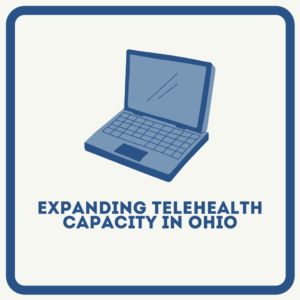Providing quality health care during the COVID-19 pandemic is challenging. Social distancing requirements and stay at home orders have pushed providers to adopt new technology and treat patients at a distance. Telehealth allows providers the opportunity to consult with patients from afar via video conferencing. The expansion of telehealth preserves the limited supply of personal protective equipment and limits face-to-face interaction to reduce the spread of the virus.
Providers across the state have begun introducing telehealth programs of their own. However, increased use of telehealth at the state and federal level is only possible due to the elimination of regulations around telehealth services. On March 19, Governor DeWine signed an executive order to expand access to medical and behavioral health services via telehealth. This order expanded coverage of telehealth opportunities for Medicaid beneficiaries. On April 4, Governor DeWine signed another executive order that effectively allows Ohioans to more easily access telehealth services from individual counselors, social workers, marriage counselors, and family counselors without the requirement to have an initial in-person appointment first. At the federal level, the Centers for Medicare and Medicaid Services (CMS) announced the expansion of telehealth services on March 30, encouraging state programs and private payers to follow suit. Limits on telehealth care for Medicare patients were also lifted to continue the treatment of seniors during the pandemic.
Mental and behavioral healthcare is of critical importance during the pandemic. Isolation and increased stress pose a great risk to mental and behavioral health patients. Telehealth allows counseling and check-ins to continue, with crisis hotlines and behavioral health clinics seeing a rise in telehealth appointments relating to depression, anxiety, stress, and relationships. Healthcare workers are optimistic that telehealth capacity will remain after the COVID-19 pandemic subsides. Telehealth presents the opportunity for care to reach underserved populations who have not historically had access to services. Telehealth overcomes traditional barriers such as lack of transportation and proximity to a provider. While telehealth will never replace face-to-face care, it is a technological advancement which providers should consider taking advantage of on a more regular basis.

